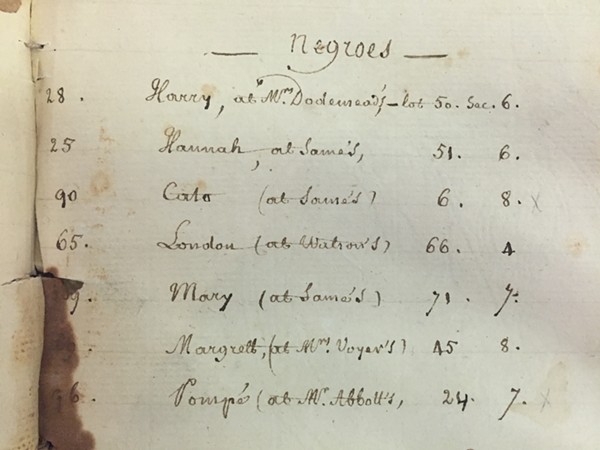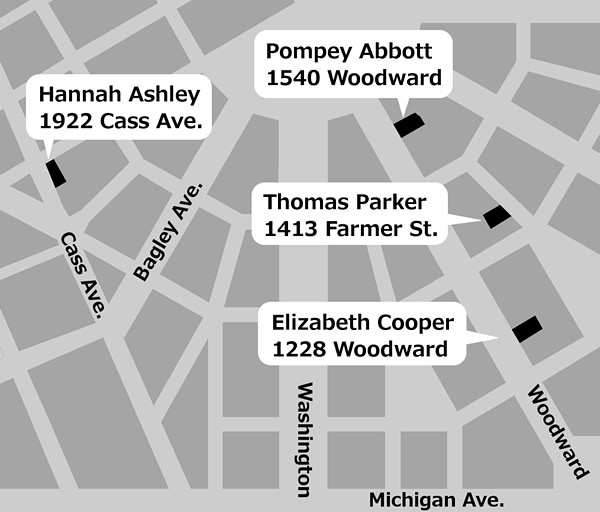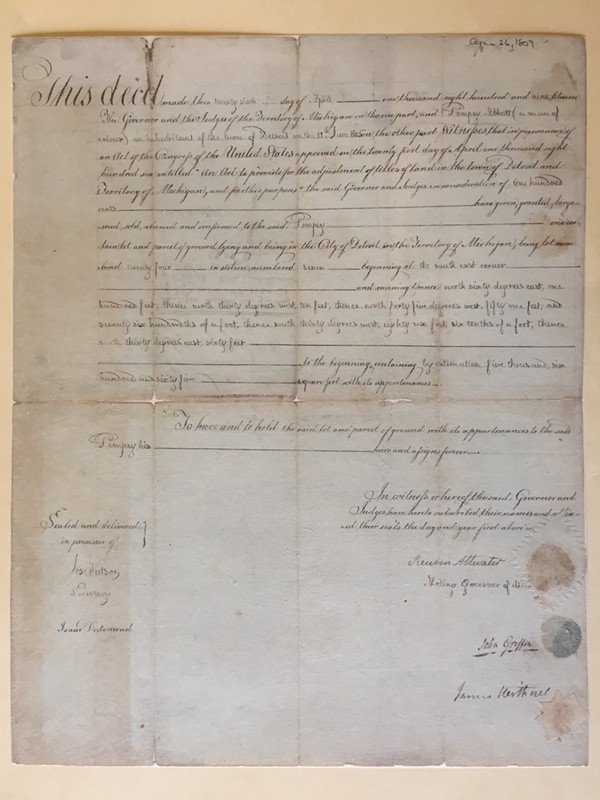For African Americans, the struggle to own property in Detroit is almost as old as the city itself — tactics like redlining, restrictive covenants, and mob violence were long used to prevent black Detroiters from purchasing homes. And while, the city enjoyed a higher-than-average black homeownership rate by 2000, the recent subprime mortgage and tax foreclosure crises have reduced the city’s black homeownership rate to well below half. The origin story of Detroit’s fight for equal ownership rights can be traced back to the Great Fire of 1805. Although there were a few black landowners among the riverfront farms near Detroit at the time, no African Americans owned land in the town itself. But after the fire, the young nation’s Congress promised a free lot in the new city to every adult who resided there at the time of the fire, regardless — in theory — of wealth, class, gender, or race.
To understand how and why land was distributed after the fire, let’s first cover some historical background.
The Act of 1806
Nineteen days after the great fire, the Michigan Territory came into existence and the ruins of Detroit became its capital. The territorial government was to consist of one governor and three judges, in addition to a secretary whose role was similar to lieutenant governor. When they were sworn into office, most of Detroit’s roughly 300 residents were either crowded into farmers’ homes, or in temporary shelters built on the Commons, a large meadow surrounding the town. That area was formerly the property of French and British kings, and then owned by the U.S. government. It was here that Augustus B. Woodward, one of the territorial judges, proposed rebuilding the new Detroit.
Governor William Hull and Judge Woodward lobbied Congress for permission to plan the new town on the federally owned Commons, leading to the passage of “An Act to provide for the adjustment of titles of land in the town of Detroit and territory of Michigan, and for other purposes” on April 21, 1806. In addition to granting the governor and judges the authority to plan a new territorial capital and issue deeds for property within it, the following provision was included:
And to every person, or the legal representative or representatives of every person, who, not owning or professing allegiance to any foreign power, and being above the age of seventeen years, did, on the eleventh day of June, 1805, when the old town of Detroit was burnt, own or inhabit a house in the same, there shall be granted, by the governor and judges aforesaid, or any three of them, and where they shall judge most proper, a lot, not exceeding the quantity of five thousand square feet.
Beginning that autumn, the governor and at least two of the three territorial judges held regular meetings as a Land Board to carry out their duties as the law directed. At their first meeting on September 8, 1806, they elevated Detroit from township to city status and codified Judge Woodward’s plan as the new basis of the city. They also determined that each recipient of a “free” lot would be required to pay one dollar to receive a copy of his or her deed. But when it came time to decide how the “donation lots” were to be allocated, egalitarianism dissolved into months of contentious bickering over who was entitled to the most valuable lots, and who would have first choice.
After failing to reach a consensus that met the citizens’ approval, the Land Board on Nov. 21, 1806 tasked Governor Hull with devising a solution once and for all. Adopting a previous suggestion, Hull divided potential claimants into several classes: Former property owners came first, heads of households who rented came second, and everybody else came third. On Dec. 31, Detroiters in the first and second classes drew ballots to determine which lot they would receive, contingent upon approval. An original handwritten copy of the governor’s report survives, listing claimants by class with the lot and section number they drew. Detroiters of the third class drew their ballots on Jan. 3, 1807.
The names of at least three free African Americans — Tom Parker, Elizabeth Cooper, and Hannah “at Mrs. Coate’s” — were included in the list of third-class claimants. At the very bottom of this class, in a separate list labeled “Negroes,” are the names of seven slaves: Harry, Hannah, and Cato (“at Mrs. Dodemead’s); London and Mary (“at Watson’s”); Margaret (“at Mrs. Voyer’s”), and Pompey (“at Mr. Abbott’s”).
Each one of these individuals drew a ballot for their donation lot, but only a handful would actually receive deeds to their property.
“Pompey”
Sometimes the historical record can be used to trace not only the past ownership of land, but the possession of human beings as well. Found among the documents of prominent Detroiter Joseph Campau after his death was a bill of sale for an African American man, Pompey, to James May of Detroit for £38 sterling, dated June 1792. Two years later, May sold Pompey to John Askin for £45. Askin sold him in 1795 to James Donaldson for £50.
Although “Pompey” was a common slave name, it is likely that this was the same man who was enslaved by James Abbott, Jr. at the time of the 1805 fire. Abbott was born in Detroit in 1775 into one of Detroit’s wealthiest families, later becoming a successful lawyer and merchant. Incidentally, he was an uncle and the namesake of artist James Abbott McNeil Whistler.
At a meeting of the Land Board on Dec. 15, 1808, the minutes record that “a deed for lot 24, section 7, was ordered to be issued to Pomp [sic], a negro man.” The deed, eventually issued April 26, 1809, conveyed the property to “Pompey Abbott, (a man of colour) an inhabitant of the town of Detroit, on the 11th of June, 1805,” and bears the signatures of Territorial Secretary Reuben Atwater (as acting governor) and Judges John Griffin and James Witherell. Amazingly, the original deed has survived, and is preserved in the Abbott family papers at the Burton Historical Collection.
Pompey’s lot was 60 feet wide by 100 feet deep, with its northeast corner clipped off by a turn in the rear alley. The site is the present day location of Bleu Detroit, a nightclub located at 1540 Woodward Ave. This Steamline Moderne building, designed by Cyril E. Schley, opened in 1942 as the Telenews Theater.
Pompey died less than five years later, never having sold his property and leaving no heirs. In that brief time, the slice of land, which since 1701 had been in the possession of the King of France, the King of England, and the United States of America, was the property of Pompey, a slave in Detroit. Ultimately, it was merely a symbolic victory, providing no material benefit to rectify the injustice he endured.
Twelve years after Pompey’s death, James Abbott, Jr. unlawfully sold Pompey’s lot to Thomas Cliff for $300 in 1836, extracting a final unearned profit from the man whom he regarded as property. The flaw in the title was evidently discovered, because Abbott found it necessary on Feb. 2, 1846 to petition Wayne County Probate Court to be appointed administrator of Pompey’s estate. He couldn’t remember exactly when his beloved servant died — his petition states that it was “January or February” of 1814. But Abbott did supposedly remember that Pompey owed him money, and had the gall to claim, in court documents, to be a creditor of the man he enslaved. The court appointed Abbott guardian and administrator of the estate, allowing him to validate his past sale of the property.
Elizabeth Cooper
A deed for lot 37 in section 7 was ordered for Elizabeth Cooper at a meeting of the Land Board on Dec. 19, 1808. When the deed was drawn up, Governor Hull and Judges Griffin and Witherell signed it on Feb. 17, 1809.
Located at 1228 Woodward Ave., this lot was the home of Himelhoch’s clothing store from 1907 to 1922. The building was then acquired and demolished by J. L. Hudson’s to accommodate one of many additions to the department store. The Hudson’s building was imploded in 1998, and in 2017 ground was broken on a two-building, mixed-use development that will include Detroit’s new tallest skyscraper.
Elizabeth Cooper may have died before selling her property or leaving a will. On Jan. 31, 1824, the governor and judges relinquished her deed to a group of investors who were snatching up property in the city at the time.
Thomas Parker
Just north of Grand River Avenue on Farmer Street, next to the former PuppetART Theatre, workers are constructing a four-story segment of the new Shinola Hotel on what had long been a parking lot. The last structure to have stood here, 1413 Farmer St., was a neo-Gothic-style Detroit Edison power station constructed in 1928. This is lot 70 in section 7 in the Plan of Detroit, the parcel that Thomas Parker, a free black man, drew as his donation lot.
Acting Governor Atwater and Judges Griffin and Witherell signed the deed for this land to Parker at a meeting of the Land Board on March 18, 1809. The 1810 Detroit census shows Parker still living in the town, as the head of a household of five free non-white persons. On April 9, 1816, future Detroit mayor John R. Williams purchased Parker’s lot for $1,500. Given the Parker family’s presence within the corporation limits of Detroit in 1810 and the relatively high price that the lot sold for in 1816, it is plausible (although unlikely) that Parker built a simple home on this land.
“Hannah”
Professor Tiya Miles' recent book, The Dawn of Detroit: A Chronicle of Slavery and Freedom in the City of the Straits, recounts a legal case in which Detroiter John Dodemead petitioned the territorial court for a writ of habeas corpus for “Hannah, a negro woman, and Thomas, a mulatto boy,” whom he claimed to own. Miles speculates that Thomas was Hannah’s son, and that John Dodemead was the father. But on Oct. 3, 1809, Judge Woodward ordered Hannah and Thomas’ release, citing the testimony of William McDowell Scott, who stated that Dodemead had previously denied owning the two. "The Said Hannah & Thomas are free persons,” Woodward ruled, “and not Slaves.” Yet Hannah continued working for the Dodemead family, evidently as an employee rather than as a slave.
By the time Hannah attempted to claim her property, 12 years had passed since the day she drew lot 51 in section 6, the northeast corner of Farmer Street and Monroe Avenue. According to the Land Board’s Dec. 12, 1818 meeting minutes, Land Board Secretary Austin E. Wing, “made application in behalf of a black woman called Hannah, now living with Mrs. [Jane] Dodomeade [sic], for a deed to a lot of ground situate [sic] and lying in the City of Detroit, numbered fifty-one, in section six, as her donation lot.” But by that time, her assigned parcel was no longer available. “Whereupon,” the minutes state, “it was ordered, that she receive a deed for lot numbered eleven, in section twelve, fronting on Adams Avenue fifty feet and in depth one hundred feet, containing five thousand square feet.”
For unknown reasons, the order was not carried out. The order was issued a second time four year later on March 18, 1822. The following day, Governor Lewis Cass and Judges Woodward and Witherell signed the long-awaited deed to “Hannah, a woman of colour living with Mrs. Dodemead.”
The lot’s availability at such a late date suggests that it was not a desirable location. The area was swampy in the 1820s, and the property contained less square footage than intended due to the Cass farm’s eastern border running up against it. Today, a six-story office building at 1922 Cass Ave. covers all of Hannah’s lot and portions of the adjacent lots. This structure was built for Detroit Creamery by Albert Kahn in 1920, but its appearance has since been “modernized.”
One hopes that Hannah — clearly a persistent and resourceful individual — enjoyed a greater degree of independence later in life. John Dodemead died in 1812; his widow, Jane, followed him less than six months after Hannah obtained her property. Six years later, on Nov. 21, 1828, Hannah sold the lot to lawyer George A. O’Keeffe for $40. And the deed does not refer to the seller as “Hannah, a woman of colour,” or “Dodemead’s negro,” as some documents do— here, she is simply referred to by her own full name, Hannah Ashley.
(The handwriting on the original deed was evidently unclear, as a transcript of the document provided by the Wayne County Register of Deeds alternates between the spellings “Ashley” and “Ashby.”)
Remembering the forgotten
There were at least 10 other African American survivors of the 1805 fire, both free and enslaved, but none received property. Six of them (Harry, Cato, London, Mary, Margaret, and another Hannah) drew lots but apparently did not apply for deeds. Four individuals (Joseph Cooper, Josette, Susan, and Nell) did not even draw lots. Perhaps some could not raise the $1 to obtain their deed. A few of these individuals were likely minors at the time of the fire; wealthy Detroiters were not shy about holding children as slaves. Clearly, the four individuals who received donation lots were exceptions and not the rule.
Several Detroiters of mixed racial backgrounds received donation lots as well. John Burnett, whose mother was Potawatomie, received lot 83 in section 6 — now a vacant lot on Bates Street west of Randolph. Two women identified as “mulattos,” Mrs. Ann Hall and Miss Nancy Hall, received lots 79 and 75 in section 8, respectively. These were kitty-corner from one another, at the southwest and northwest corners of Griswold and State Street.
There are no historical markers or other public memorials to honor the few black Detroiters who, after surviving the fire of 1805, held the government to its word and acquired land they were entitled to. The names of slave owners, however, are memorialized throughout the city. Abbott Street in Corktown is named for James Abbott, Jr., the man who enslaved Pompey and stole his property. Yet there is no Pompey Street, nor even simple informational plaques to mark these historical sites. The next time you’re walking downtown, consider visiting these locations and paying your respects to the few men and women who, having every other right denied them, became property owners in Detroit at the precise moment when the city began to rise from the ashes.
Paul Sewick operates Detroit Urbanism, a blog about the history of city roads, borders, and infrastructure. He also contributes to Curbed Detroit.









